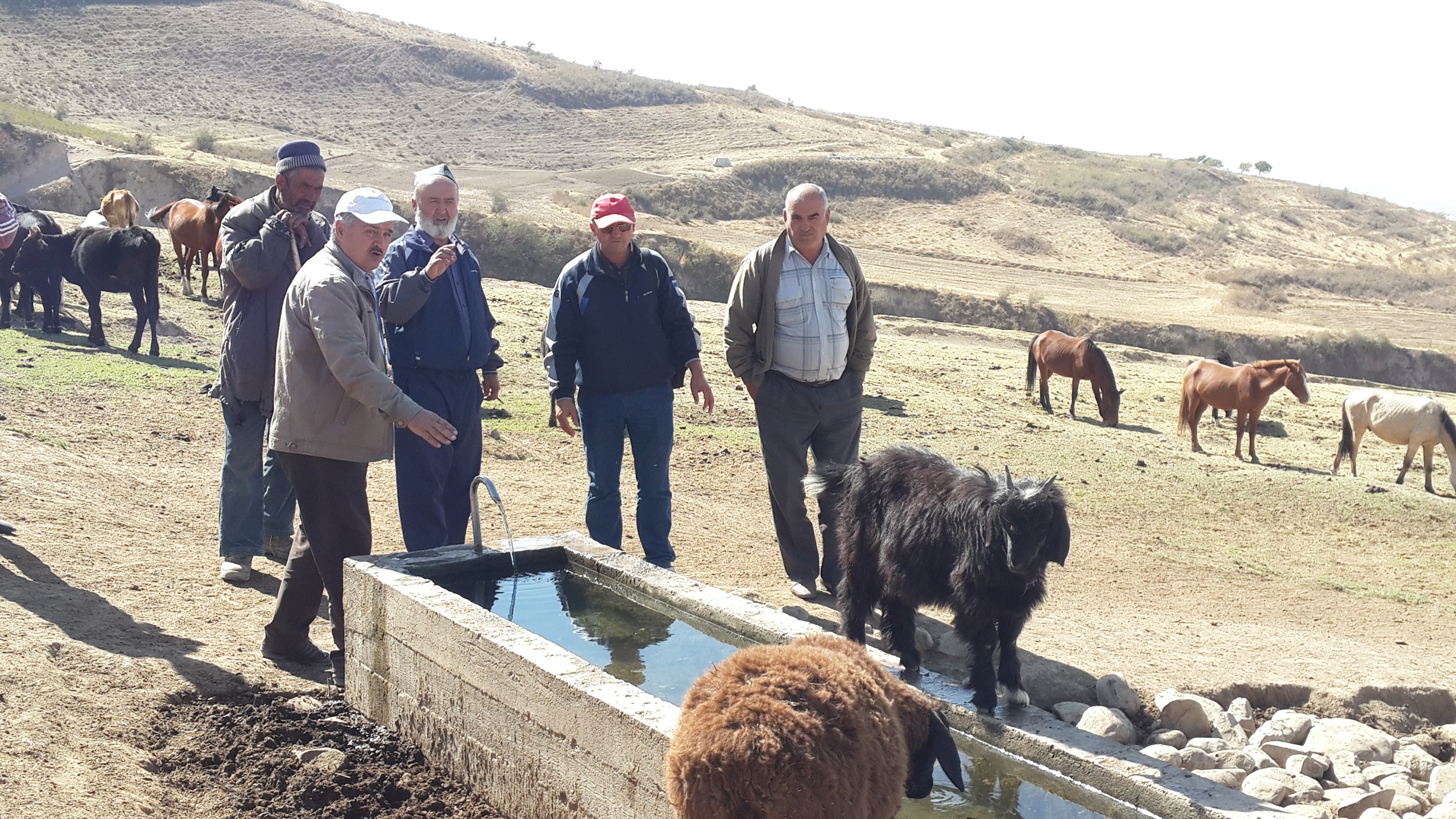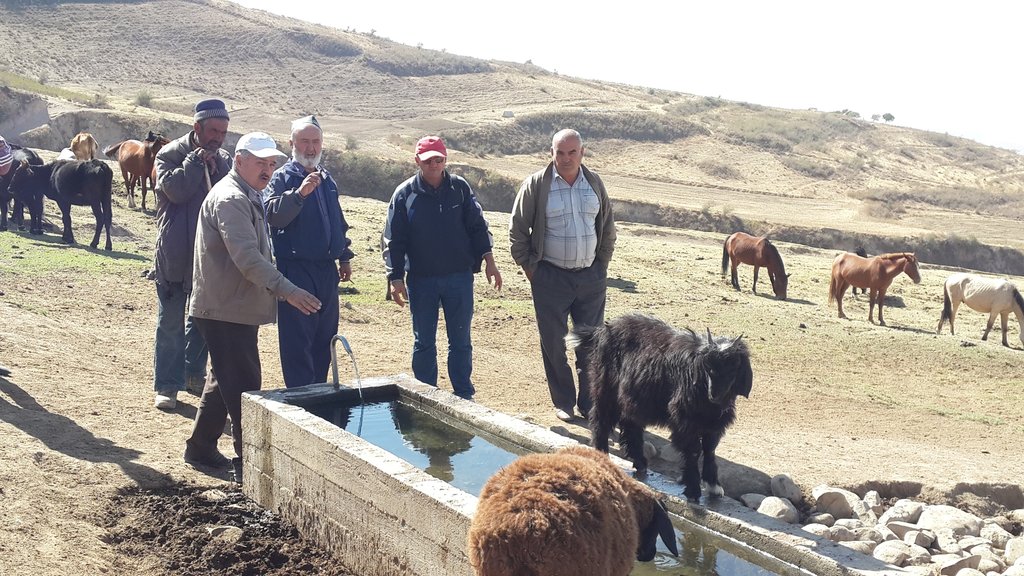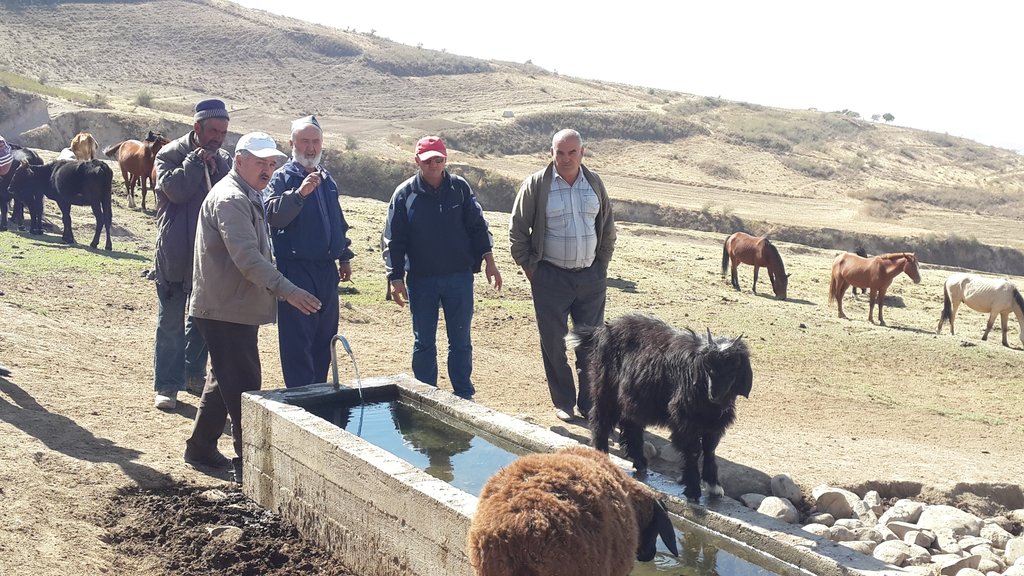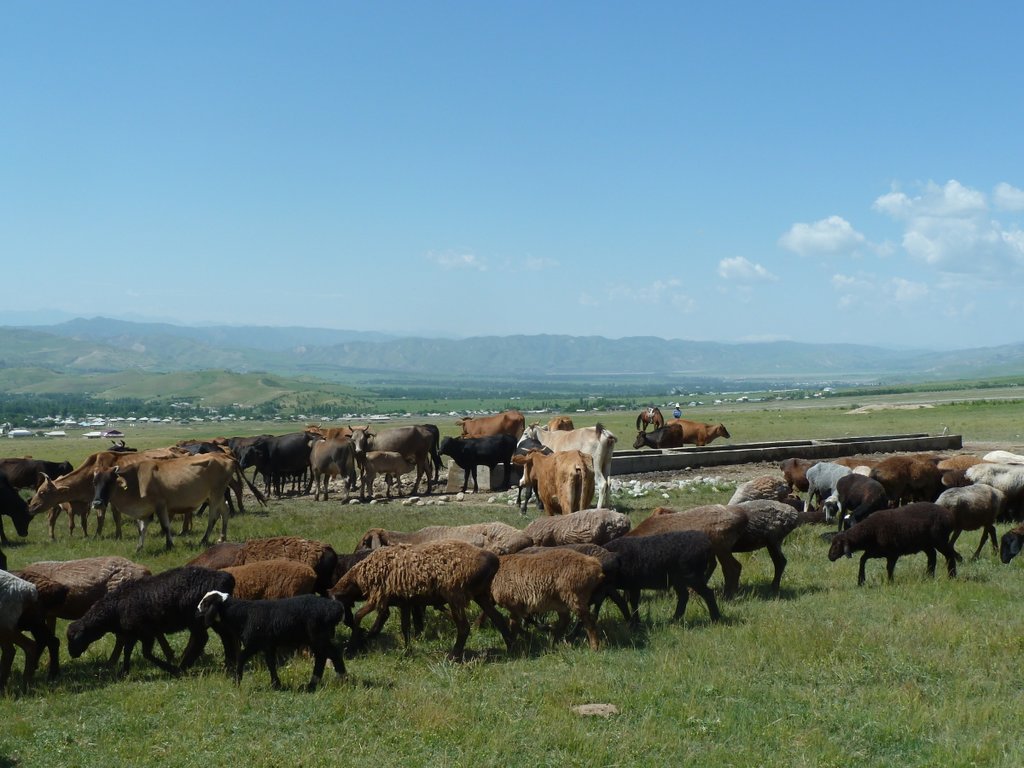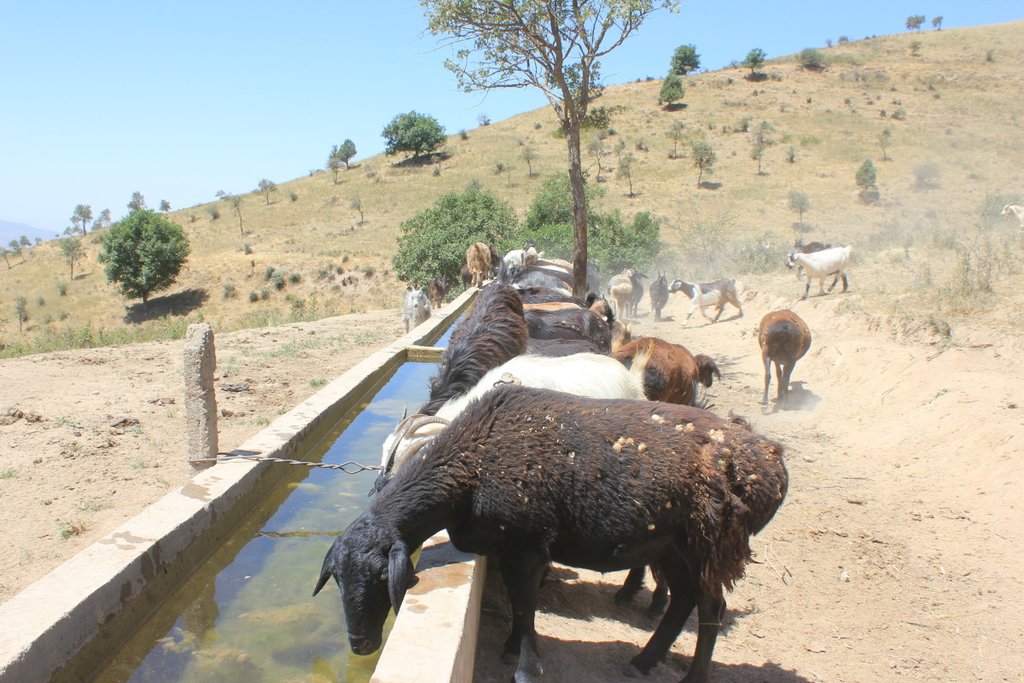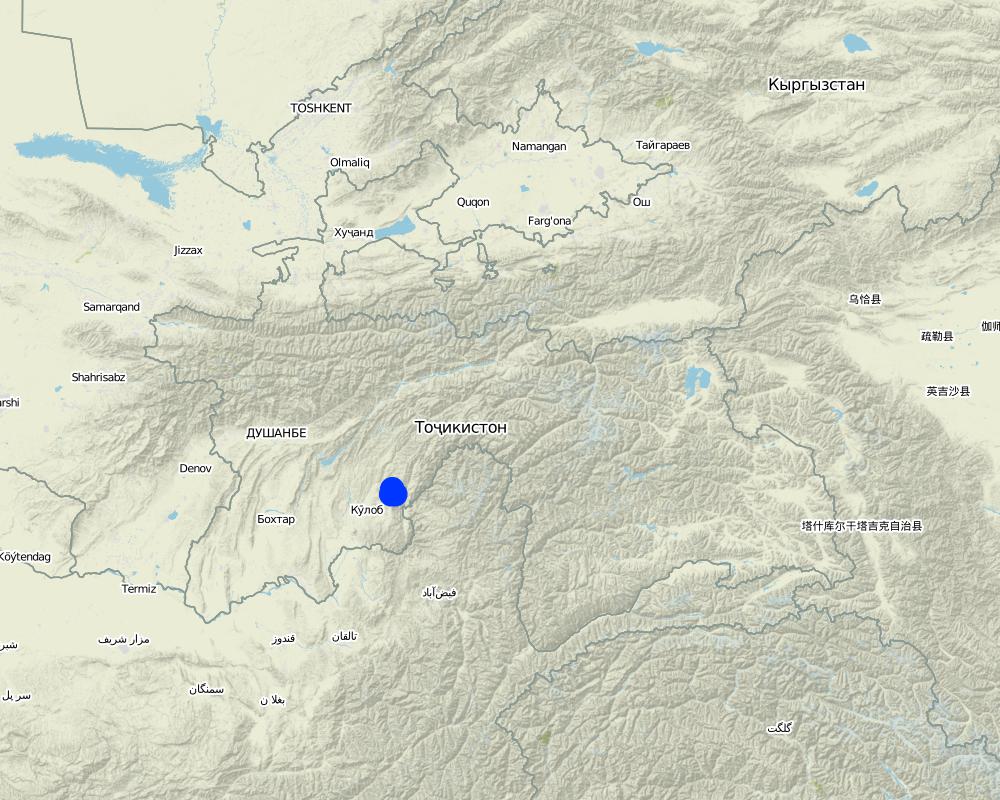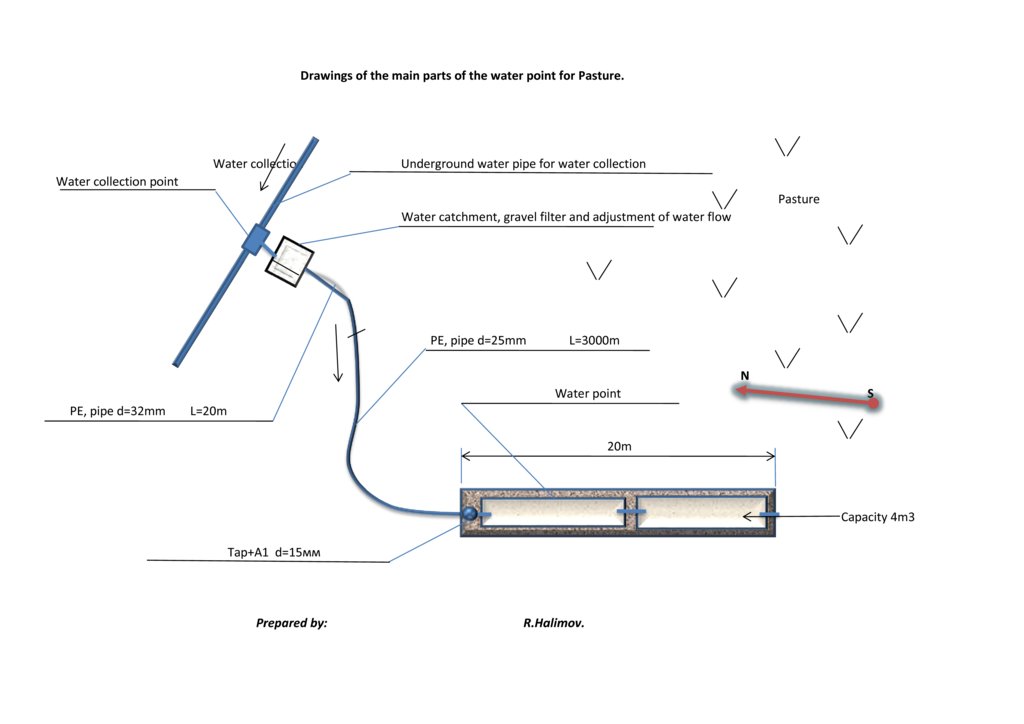Water points for livestock in daily pastures [塔吉克斯坦]
- 创建:
- 更新:
- 编制者: Nicole Stolz
- 编辑者: Boris Orlowsky, Sa'dy Odinashoev
- 审查者: Nicole Harari, Alexandra Gavilano, Alvin Chandra
Нуқтаи обнушии чорво
technologies_623 - 塔吉克斯坦
查看章节
全部展开 全部收起1. 一般信息
1.2 参与该技术评估和文件编制的资源人员和机构的联系方式
有助于对技术进行记录/评估的项目名称(如相关)
Book project: where people and their land are safer - A Compendium of Good Practices in Disaster Risk Reduction (DRR) (where people and their land are safer)有助于对技术进行记录/评估的机构名称(如相关)
CARITAS (Switzerland) - 瑞士1.3 关于使用通过WOCAT记录的数据的条件
编制者和关键资源人员接受有关使用通过WOCAT记录数据的条件。:
是
1.4 所述技术的可持续性声明
这里所描述的技术在土地退化方面是否存在问题,导致无法被认为是一种可持续的土地管理技术?:
否
1.5 参考关于SLM方法(使用WOCAT记录的SLM方法)的调查问卷
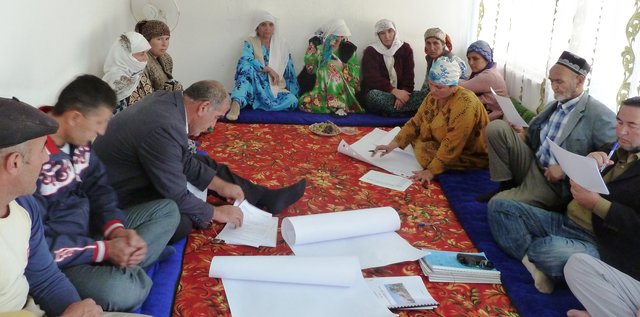
Pasture User Union [塔吉克斯坦]
Livestock holders at village level join a pasture user union to access different rights provided under the national law "About pastures" passed in 2013. Among others, the Paster User Unions (PUUs) are able to obtain onwership of a communal collective pasture land, have the right to collect fees to improve …
- 编制者: Boris Orlowsky
2. SLM技术的说明
2.1 技术简介
技术定义:
Water points for daily use in pastures, reducing erosion and enhancing productivity of cattle and other livestock.
2.2 技术的详细说明
说明:
Bringing water from springs or other sources to water points in pastures greatly increases livestock productivity and improves reproductive performance. Difficult and distant access to water exhausts the animals, reducing production of meat and milk and reproductive capacities by up to 50%.
By providing water points in pastures, negative effects on livestock productivity can be reduced to a minimum. In order to implement the technology, water sources with perennial flow have to be identified with the shortest possible distance to and from the different grazing grounds. As a next step, in Tajikistan, water and land ownership and user rights must be regulated. Rights to pasture users are either given by the community or individual land and water owners. If the water source and a location for construction are found within a reasonable distance of the different pasture grounds, a drinking water system for livestock can be designed and constructed. Construction involves spring water collection , laying of pipes
and finally installation of the water point. Besides the direct benefits (i.e. increased productivity and reproduction), the water points in the pastures reduce erosion from cattle tracks in often critical locations such as steep slopes surrounding springs. Water points also protect springs from being destroyed or spoiled by the animals. Thus the technology has a risk reduction benefit. A potential negative effect of the technology is a reduction of biodiversity, as extracting water from catchment springs may result in fewer natural fauna and flora in the micro-environments around the springs.
2.3 技术照片
2.4 技术视频
位置:
Muminabad district
2.5 已应用该技术的、本评估所涵盖的国家/地区/地点
国家:
塔吉克斯坦
区域/州/省:
Khatlon
有关地点的进一步说明:
Muminabad, Dehbaland
具体说明该技术的分布:
- 适用于特定场所/集中在较小区域
Map
×2.6 实施日期
注明实施年份:
2014
2.7 技术介绍
详细说明该技术是如何引入的:
- 通过项目/外部干预
注释(项目类型等):
By a Caritas Switzerland project
3. SLM技术的分类
3.1 该技术的主要目的
- 改良生产
- 减少、预防、恢复土地退化
- 结合其他技术保护流域/下游区域
- 降低灾害风险
- 创造有益的经济影响
- 创造有益的社会影响
3.2 应用该技术的当前土地利用类型

牧场
粗放式放牧:
- 半游牧畜牧业
注释:
Livestock density (if relevant):
high
3.4 供水
该技术所应用土地的供水:
- 雨养
注释:
Number of growing seasons per year:
2
3.5 该技术所属的SLM组
- 畜牧业和牧场管理
- 地表水管理(泉、河、湖、海)
3.6 包含该技术的可持续土地管理措施

结构措施
- S7:集水/供水/灌溉设备
3.7 该技术强调的主要土地退化类型

土壤水蚀
- Wt:表土流失/地表侵蚀
- Wg:冲沟侵蚀/沟蚀

土壤风蚀
- Et:表土流失

物理性土壤退化
- Pc:压实
- Pu:由于其他活动而导致生物生产功能的丧失
3.8 防止、减少或恢复土地退化
具体数量名该技术与土地退化有关的目标:
- 减少土地退化
注释:
Water points in daily pastures lead to less movements of herds from and to natural water sources, as water is brought to the animals. Densitiy of animals around natural water sources lead to damages by tampling through compaction of land, while overgrazing leads to vegetation losses, that lead to increased washing or blowing out of soil. Trampling can as well destroy a natural water source and make it unusable.
4. 技术规范、实施活动、投入和成本
4.1 该技术的技术图纸
技术规范(与技术图纸相关):
Water is collected in underground pipes and from surface runoff, passes through a filter which additionally regulates the flow and is led to the water point structure. The length of the tubes (see drawing) allows for collecting water from a surface of several hectars. The structure is made of concrete and consists of two basins, holding together approx. 4m3 of water.
作者:
R. Halimov
日期:
16/03/2015
4.2 有关投入和成本计算的一般信息
具体说明成本和投入是如何计算的:
- 每个技术单元
指定单位:
one water point
指定单位面积(如相关):
18m, 4,5m3
其它/国家货币(具体说明):
Tajik Somoni
如相关,注明美元与当地货币的汇率(例如1美元=79.9巴西雷亚尔):1美元=:
8.0
注明雇用劳工的每日平均工资成本:
45 Somoni (5.5 USD per day)
4.3 技术建立活动
| 活动 | 时间(季度) | |
|---|---|---|
| 1. | Identify water sources (spring detection) | early spring and late autumne (observe at least over two years) |
| 2. | Identify where a potential water point should be placed in the pasture area | N/A |
| 3. | Identify the land ownership | N/A |
| 4. | Design of the system | N/A |
| 5. | Tapping and protecting the spring | summer |
| 6. | Digging trenches and lay pipes | Spring |
| 7. | Connecting the tubes to spring catchment | N/A |
| 8. | Construct water point | N/A |
4.4 技术建立所需要的费用和投入
| 对投入进行具体说明 | 单位 | 数量 | 单位成本 | 每项投入的总成本 | 土地使用者承担的成本% | |
|---|---|---|---|---|---|---|
| 劳动力 | Labour | person/days | 77.0 | 45.0 | 3465.0 | 20.0 |
| 设备 | Material Transport Dushanbe-Muminabad | trips (truck with diver) | 1.0 | 3050.0 | 3050.0 | |
| 设备 | Transport in the district Center to construction place | trips (truck with driver) | 3.0 | 150.0 | 450.0 | |
| 植物材料 | Tubes | m | 1820.0 | 4.0 | 7280.0 | |
| 植物材料 | Cement | kg | 1800.0 | 1.06 | 1908.0 | |
| 植物材料 | Gravel | m3 | 6.0 | 180.0 | 1080.0 | |
| 施工材料 | Tubes | m | 1820.0 | 4.0 | 7280.0 | |
| 施工材料 | Cement | kg | 1800.0 | 1.06 | 1908.0 | |
| 施工材料 | Gravel | m3 | 6.0 | 180.0 | 1080.0 | |
| 技术建立所需总成本 | 27501.0 | |||||
| 技术建立总成本,美元 | 3437.63 | |||||
如果您无法分解上表中的成本,请估算建立该技术所需要的总成本。:
15000.0
如果土地使用者负担的费用少于100%,请注明由谁负担其余费用:
Integrated Watershed Management Project, Caritas Switzerland
4.5 维护/经常性活动
| 活动 | 时间/频率 | |
|---|---|---|
| 1. | Close/open water point during winter time / spring | twice per year |
| 2. | Small repairs | twice per year |
注释:
Water points from cement are not that intensive for maintenance, Herders will take care of the water points as they are daily there. It is important that the tube system is fully covered with soil so that the animals will not destroy any open laying tubes.
4.6 维护/经常性活动所需要的费用和投入(每年)
| 对投入进行具体说明 | 单位 | 数量 | 单位成本 | 每项投入的总成本 | 土地使用者承担的成本% | |
|---|---|---|---|---|---|---|
| 劳动力 | Clean outlet of water point to reduce erosion | days | 2.0 | 45.0 | 90.0 | |
| 劳动力 | Control spring catchment (illegal cutting of trees, any other changes in vegetation to assess output of spring) and line | days | 2.0 | 45.0 | 90.0 | |
| 劳动力 | Control water line - walk along the tubes and control for leackeges) | days | 1.0 | 45.0 | 45.0 | |
| 设备 | showel | item | 1.0 | 150.0 | 150.0 | |
| 施工材料 | Water Tab | item | 1.0 | 500.0 | 500.0 | 100.0 |
| 施工材料 | Gravel bed around water point | kg | 20.0 | 20.0 | 400.0 | |
| 施工材料 | Replacement of tubes | m | 200.0 | 4.0 | 800.0 | |
| 技术维护所需总成本 | 2075.0 | |||||
| 技术维护总成本,美元 | 259.38 | |||||
如果您无法分解上表中的成本,请估算维护该技术所需要的总成本。:
2075.0
4.7 影响成本的最重要因素
描述影响成本的最决定性因素:
Cost for pipes and cement, i.e. the distance of the next suitable spring to the pasture area;
land ownership: state owned land rented to the Pasture Union
5. 自然和人文环境
5.1 气候
年降雨量
- < 250毫米
- 251-500毫米
- 501-750毫米
- 751-1,000毫米
- 1,001-1,500毫米
- 1,501-2,000毫米
- 2,001-3,000毫米
- 3,001-4,000毫米
- > 4,000毫米
指定年平均降雨量(若已知),单位为mm:
800.00
有关降雨的规范/注释:
Spring and autumne rainfall
农业气候带
- 半干旱
continental climate
5.2 地形
平均坡度:
- 水平(0-2%)
- 缓降(3-5%)
- 平缓(6-10%)
- 滚坡(11-15%)
- 崎岖(16-30%)
- 陡峭(31-60%)
- 非常陡峭(>60%)
地形:
- 高原/平原
- 山脊
- 山坡
- 山地斜坡
- 麓坡
- 谷底
垂直分布带:
- 0-100 m a.s.l.
- 101-500 m a.s.l.
- 501-1,000 m a.s.l.
- 1,001-1,500 m a.s.l.
- 1,501-2,000 m a.s.l.
- 2,001-2,500 m a.s.l.
- 2,501-3,000 m a.s.l.
- 3,001-4,000 m a.s.l.
- > 4,000 m a.s.l.
说明该技术是否专门应用于:
- 凸形情况
5.3 土壤
平均土层深度:
- 非常浅(0-20厘米)
- 浅(21-50厘米)
- 中等深度(51-80厘米)
- 深(81-120厘米)
- 非常深(> 120厘米)
土壤质地(表土):
- 中粒(壤土、粉土)
土壤质地(地表以下> 20厘米):
- 细粒/重质(粘土)
表土有机质:
- 中(1-3%)
5.4 水资源可用性和质量
地下水位表:
> 50米
地表水的可用性:
中等
水质(未处理):
良好饮用水
水的盐度有问题吗?:
否
该区域正在发生洪水吗?:
是
规律性:
频繁
5.5 生物多样性
物种多样性:
- 中等
栖息地多样性:
- 中等
5.6 应用该技术的土地使用者的特征
定栖或游牧:
- 定栖的
生产系统的市场定位:
- 混合(生计/商业)
非农收入:
- 收入的10-50%
相对财富水平:
- 贫瘠
个人或集体:
- 团体/社区
机械化水平:
- 畜力牵引
性别:
- 男人
土地使用者的年龄:
- 中年人
说明土地使用者的其他有关特征:
cattle and livestock grazing is a male task, animals at home are taken care by women
5.7 应用该技术的土地使用者使用的平均土地面积
- < 0.5 公顷
- 0.5-1 公顷
- 1-2 公顷
- 2-5公顷
- 5-15公顷
- 15-50公顷
- 50-100公顷
- 100-500公顷
- 500-1,000公顷
- 1,000-10,000公顷
- > 10,000公顷
这被认为是小规模、中规模还是大规模的(参照当地实际情况)?:
- 中等规模的
注释:
range land at community level is about 300 ha, single farmers have about 1 ha cropland
5.8 土地所有权、土地使用权和水使用权
土地所有权:
- 州
土地使用权:
- 社区(有组织)
用水权:
- 社区(有组织)
注释:
water is owned by the pasture user union
5.9 进入服务和基础设施的通道
健康:
- 贫瘠
- 适度的
- 好
教育:
- 贫瘠
- 适度的
- 好
技术援助:
- 贫瘠
- 适度的
- 好
就业(例如非农):
- 贫瘠
- 适度的
- 好
市场:
- 贫瘠
- 适度的
- 好
能源:
- 贫瘠
- 适度的
- 好
道路和交通:
- 贫瘠
- 适度的
- 好
饮用水和卫生设施:
- 贫瘠
- 适度的
- 好
金融服务:
- 贫瘠
- 适度的
- 好
6. 影响和结论性说明
6.1 该技术的现场影响
社会经济效应
生产
畜牧生产
SLM之前的数量:
0
SLM之后的数量:
50%
注释/具体说明:
more meat, milk (avarage 1 l before, after 3 liter) and higher productivity (every second year, now every year)
水资源可用性和质量
家畜用水的可用性
SLM之前的数量:
0
SLM之后的数量:
permanently availible
注释/具体说明:
There is no water availible before the intervention in the pasture area, but animals need to walk for several km to reach water down in the valley or even back at the villages
家畜用水的质量
注释/具体说明:
Animals have access to improved water quality (i.e. tab water).
收入和成本
农业收入
SLM之后的数量:
30% increase
注释/具体说明:
Animals are healthier. Farmers have more milk and meat due to improved access to water and less movement during the day.
工作量
注释/具体说明:
Work for herders got easier, as they have to walk less with the animals to find water.
生态影响
水循环/径流
地表径流
注释/具体说明:
Negative side effect, as water beyond the need of animals runs off unused.
减少气候和灾害风险
滑坡/泥石流
注释/具体说明:
Erosion reduced due to improved land cover as anmials do not go into spring atchments. Reduced movements of animals reduce as well trampling and loss of vegetation cover in watershed areas.
干旱影响
注释/具体说明:
Tabbed water remains accesible in droughts.
6.2 该技术的场外影响已经显现
对场外影响(测量)的评估进行具体说明:
none
6.3 技术对渐变气候以及与气候相关的极端情况/灾害的暴露和敏感性(土地使用者认为的极端情况/灾害)
渐变气候
渐变气候
| 季节 | 增加或减少 | 该技术是如何应对的? | |
|---|---|---|---|
| 年降雨量 | 减少 | 适度 |
气候有关的极端情况(灾害)
气候灾害
| 该技术是如何应对的? | |
|---|---|
| 寒潮 | 非常不好 |
注释:
Water points need to be closed during winter time, otherwise the tubes will get destroyed due to freezing.
6.4 成本效益分析
技术收益与技术建立成本相比如何(从土地使用者的角度看)?
短期回报:
积极
长期回报:
非常积极
技术收益与技术维护成本/经常性成本相比如何(从土地使用者的角度看)?
短期回报:
非常积极
长期回报:
积极
注释:
Land users did not bear the full costs they benefit strongly from the beginning
6.5 技术采用
- 11-50%
如若可行,进行量化(住户数量和/或覆盖面积):
20 water points have been established that are used by more than one village herds
在所有采用这项技术的人当中,有多少人是自发的,即未获得任何物质奖励/付款?:
- 0-10%
注释:
The project subsidized the construction of water points. Livestock breeders from other districts have participated by observing the use of technology
6.6 适应
最近是否对该技术进行了修改以适应不断变化的条件?:
否
6.7 该技术的优点/长处/机会
| 土地使用者眼中的长处/优势/机会 |
|---|
| Improved water management has improved livestock production by controlled grazing and access to water at daily pasture points. |
| Transporting livestock from steep valley locations to water drinking points was previously labour intensive, a farming activity which has improved due to dedicated water points. |
| Water quality at drinking points is good enough to be used by farmer and herders as well. |
| 编制者或其他关键资源人员认为的长处/优势/机会 |
|---|
| Erosion by livestock has been reduced as livestock grazing is more controlled and distributed compared to before the project interventions. |
6.8 技术的弱点/缺点/风险及其克服方法
| 土地使用者认为的弱点/缺点/风险 | 如何克服它们? |
|---|---|
| Water points and farms are remote, and construction requires machinery and a challenging transport of materials to upper pasture zones. |
| 编制者或其他关键资源人员认为的弱点/缺点/风险 | 如何克服它们? |
|---|---|
| Investment costs are still considered to be too high to be fully borne by pasture users | Pasture User Union have been formed which collects fees. The unions help to save money for technology investments. |
7. 参考和链接
7.1 信息的方法/来源
- 实地考察、实地调查
3 informations, 1 engineer and 1 SLM specialist
- 与土地使用者的访谈
3 Herders
(现场)数据是什么时候汇编的?:
11/10/2016
7.2 参考可用出版物
标题、作者、年份、ISBN:
n/a
7.3 链接到网络上的相关信息
标题/说明:
Disaster RIsk Management in Tajikistan
URL:
https://www.caritas.ch/de/was-wir-tun/engagement-weltweit/klimaschutz-und-katastrophenpraevention/
链接和模块
全部展开 全部收起链接

Pasture User Union [塔吉克斯坦]
Livestock holders at village level join a pasture user union to access different rights provided under the national law "About pastures" passed in 2013. Among others, the Paster User Unions (PUUs) are able to obtain onwership of a communal collective pasture land, have the right to collect fees to improve …
- 编制者: Boris Orlowsky
模块
无模块


